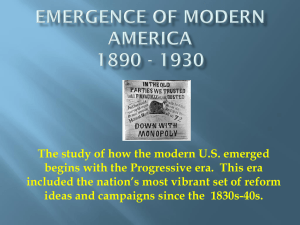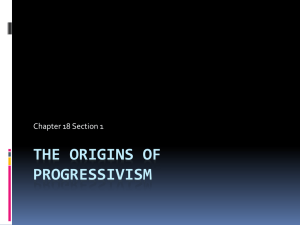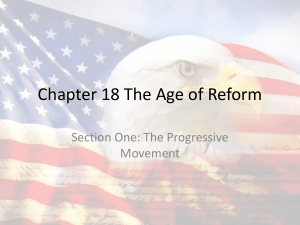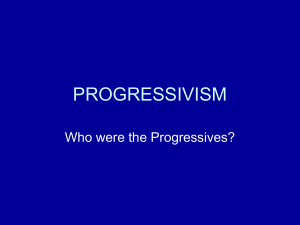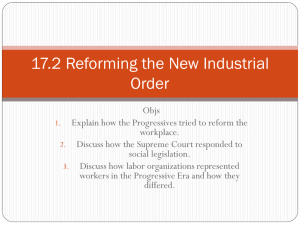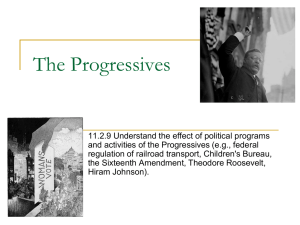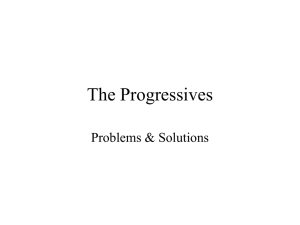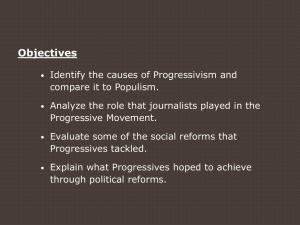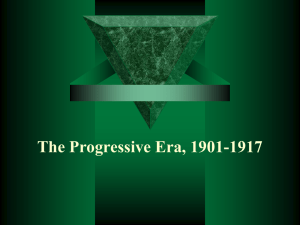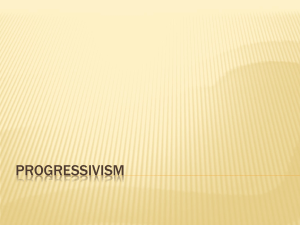Social Class, Social Action, and Education:
advertisement
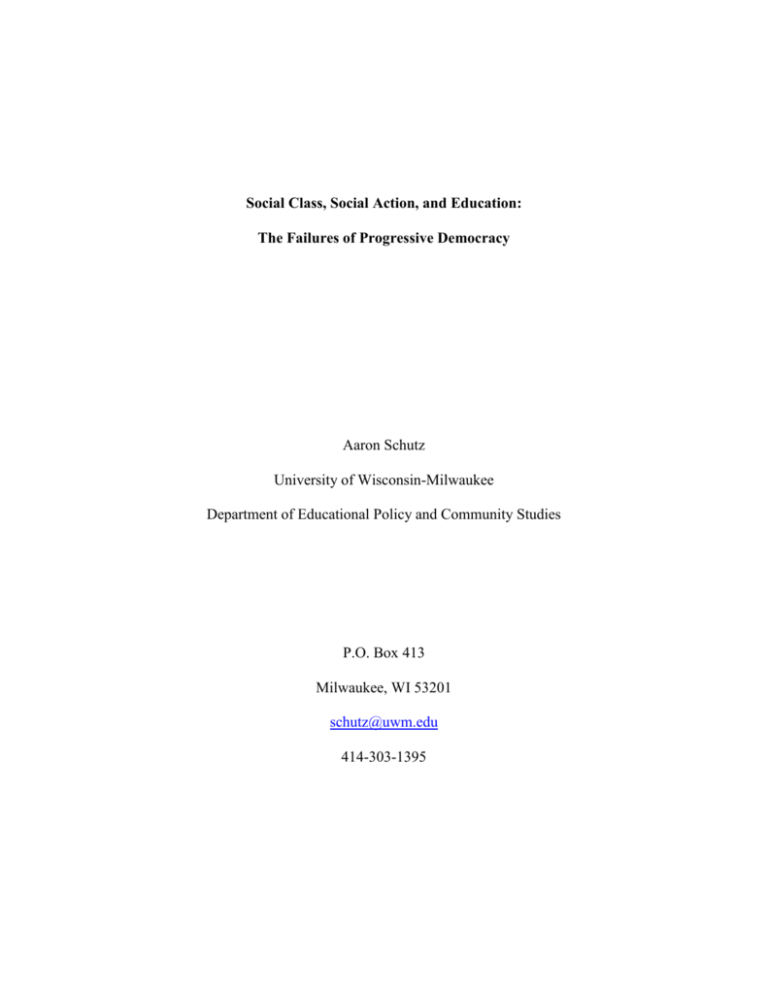
Social Class, Social Action, and Education: The Failures of Progressive Democracy Aaron Schutz University of Wisconsin-Milwaukee Department of Educational Policy and Community Studies P.O. Box 413 Milwaukee, WI 53201 schutz@uwm.edu 414-303-1395 Listen to me, college boy, you can keep your museums and poetry and string quartets ‘cause there’s nothing more beautiful than [power] line work. --Todd Jaileri Dedication To my mother, who was, in her own idiosyncratic way, a true scholar. She always got mad when she read my papers for school. “You just banged this out, and you’re going to get an A,” she would complain. “You could do so much better if you took the time to actually think about what you are saying.” I didn’t bang this one out, mom. Acknowledgements This book represents more than a decade of work, of following my nose through unexpected turns and twists. Over this time, I collected debts to those who helped me find my way. At the University of Michigan, my most important mentor was Pamela Moss, who taught me what it means to be a professional in the scholarly arena. I would not have accomplished near as much without her support and friendship. Jay Robinson took a chance on a candidate with an odd background for their Ph.D. program and trusted that I’d find my way, somehow. Larry Berlin gave encouragement and the model of his own strong commitment to old-fashioned scholarship. Others who read portions of this work and provided helpful comments include Todd DeStigter, David Granger, Craig Cunningham, and Jim Garrison. Dee Russell Phillips probably forgets that he gave me a read from a distance and asked whether I really thought Dewey was as stupid as I had made him out to be (framed much more kindly than that, of course). I have kept this question in mind ever since. I’m sure I have forgotten others. These critics and supporters are, of course, fully responsible for any mistakes that remain in the current manuscript. This volume could not have been written without the support and love of my family: my wife, Jessica, and my daughters Hiwot and Sheta who, when asked what daddy loves best, answer “being on the computer.” Table of Contents Acknowledgements ......................................................................................................................... 4 Introduction………………………………………………………………………………………..6 Part I: Overview ............................................................................Error! Bookmark not defined. Chapter One: Social Class and Social Action ..........................Error! Bookmark not defined. Part II: Collaborative Progressivism .............................................Error! Bookmark not defined. Chapter Two: John Dewey’s Conundrum: Can Democratic Schools Empower? ........... Error! Bookmark not defined. Chapter Three: John Dewey and a “Paradox of Size”: Faith at the Limits of Experience .............................................................................Error! Bookmark not defined. Part III: Personalist Progressivism ................................................Error! Bookmark not defined. Chapter Four: The Lost Vision of 1920s Personalists .............Error! Bookmark not defined. Chapter 5: The Free Schools Movement ................................Error! Bookmark not defined. Part IV: Democratic Solidarity .....................................................Error! Bookmark not defined. Chapter 6: Community Organizing: A Working-Class Approach to Democratic Empowerment .....................................................Error! Bookmark not defined. Part V: Case Study ........................................................................Error! Bookmark not defined. Chapter 7: Social Class and Social Action in the Civil Rights Movement .. Error! Bookmark not defined. Part VI: Conclusion.......................................................................Error! Bookmark not defined. Chapter 10: Building Bridges?................................................Error! Bookmark not defined. Introductionii The term “progressive” returned with a vengeance during the first decade of the twentyfirst century. With “liberal” under attack, the left turned back to a name that rallied champions of social transformation throughout the first half of the prior century. Of course, most of those who call themselves “progressives” today are not referring to anything particularly specific -- it has mostly become a vague collective reference for a wide range of left-leaning groups. But the increasing use of the term has increased interest in progressivism as a more substantive concept and social vision, key aspects of which still reverberate through our political thinking today. This volume focuses on a fairly narrow aspect of progressivism: its conceptions of democracy. I trace how two understandings of progressive democratic practice emerged in the early decades of the twentieth century that I call “collaborative” and “personalist.” And I show how these visions of “authentic” democracy still deeply influence out ideas about social justice and education in America. “Collaborative” progressivism developed as a coherent perspective at the end of the nineteenth century among a loosely connected group of middle-class progressives -- religious leaders, scholars, and activists. Their vision of a democratic society grounded their efforts to intervene in the enormous social challenges of emerging industrialization. Together, this group imagined a world in which bureaucracy and elite control would slowly dissolve into a flat, truly collaborative, and egalitarian society. The collaborative progressives understood that America was far from their ideal, and most were realistic enough to understand that their full utopian vision was probably unachievable. Nonetheless, they threw themselves into a wide range of efforts to bring about the conditions necessary to achieve as much as they could. As I discuss in Chapter 2, the most sophisticated theorist of this democratic ideal was John Dewey. In its general outlines, however, the collaborative vision differed little across the broad range of progressive intellectuals. Some decades after the emergence of the collaborative progressives, during the “gay” twenties and later in the 1960s, as I describe in Chapters 4 and 5, another vision of holistic democracy coalesced among a different group of progressives that I call the personalists. This group has largely been forgotten in the academic literature, especially in education. Unlike the collaborative progressives, who sought pragmatic strategies for fixing a society rife with inequality and social conflict, the personalists came of age during times of relative prosperity, when it seemed likely (to them, at least) that poverty and discrimination could simply disappear by themselves. At these moments it seemed reasonable, for the relatively privileged in society at least, to leave many of collaborative progressives’ social concerns behind. The personalists focused, instead, on efforts to release on the capacities of unique individuals. They looked to romantic ideals of creative, fully embodied, and emotionally free people nurtured by authentic relationships in egalitarian communities. As I explain in more detail later on, it is because of their combination of communal and individual aims that the term “personalist” seems to fit them best. On first glance, the personalist ideal of democracy seems quite different from the apparently more sober vision of the collaborative democrats. In fact, however, the overall social aims of both groups were quite similar. As I show in Chapter 5, the core assumptions about human nature that informed both were much the same. The collaborative progressives focused on the challenges of effective joint action. The personalist progressives focused on the release of the capacities of unique individuals. And each side criticized the other for its excesses -- the collaboratives attacking personalists for their lack of a concrete vision of joint action, and the personalists attacking the collaboratives for their failure to fully appreciate the importance of creating spaces for individual freedom and authentic human relationships. But both nonetheless acknowledged and emphasized the importance of both aims. More generally, each camp sought to foster a new, more freely dialogic, and less hierarchical society. The collaboratives and the personalists, therefore, lay on a common continuum of “democratic” progressive thought. Why have these democratic ideals remain compelling for a broad range of progressive intellectuals into the twenty-first century, even though they have proved extremely difficult to enact in actual practice. The answer, I argue, lies largely among progressives themselves, among whom I count myself as a member (albeit a critical one). We like Dewey, for example, at least in part because Dewey was like us. More broadly, academics, especially in education, find collaborative and personalist visions of democracy compelling because they reflect advanced versions of the cultural practices most familiar to the vast majority of us in our families, schools, business dealings, and associations. The dreams of progressive democracy are literally embodied within the selves and social institutions of intellectuals in America. More specifically, I argue that a key influence on our long romance with progressivism has been middle-class culture. The book begins in Chapter 1, therefore, with an analysis of the emergence of the middle and working classes in the United States. I show how the middle class slowly split as a group from the working-class over the last half of the Ninteenth century, and how progressivism emerged concurrently with an increasingly distinct middle-class professional culture. This chapter lays out key characteristics of each class’s cultural life-ways, drawing together research describing relationships between class cultures and social action practices in America. Progressives of all stripes have always shied away from models of democracy drawn from the experiences of other classes. This has been especially true of models emerging out of the working class, which, from a progressive perspective, often seemed brutish and primitive. Progressives rejected working-class tendencies to emphasize the inevitability of aggressive social conflict. And progressives were uninterested in the practical demands of mass solidarity reflected in the strategies of labor unions and, more recently, community organizing groups. In fact, the “backwardness” of working-class culture was perceived from the beginning by progressives as a core social barrier to the achievement of authentic democracy. Many progressive intellectuals struggled in their writings with how to “uplift” the working-class. They sought to develop pedagogies, for example, that might initiate these “others” into adequate capacities for democratic citizenship. Even the personalists -- who often looked to more “primitive” cultures for alternatives to the banality of modern middle-class life -- were repelled by the lack of focus on individual actualization and aesthetic expression among the lower classes. In fact, a third major group of progressives, “administrative” progressives, argued that broad-based democracy was an impossibility in the modern world in no small part because of the seemingly unredeemable ignorance of the working classes. Of course, social class was not the only source of progressive discrimination. Racism was an ongoing factor as well. In this volume, however, I limit my focus to the ways that progressive racism emerged out of concerns about social class. iii The racism of so many early progressives emerged in large part out of their broader arguments about the backwardness of less “advanced” cultures, leading to judgments, for example, about what they saw as the especially deficient nature of African American culture.iv The progressives of the first half of the twentieth century were interested in more than democracy. They also sought to combat corruption and address key social inequalities. They attempted to “rationalize” a chaotic society, looking to science as a savior. And they accomplished many important social goals, including the creation of unemployment insurance, child labor laws, laws against government, the food and drug administration, and social security, among many others. The larger hopes of collaborative and personalist progressives for a more democratic society, however, met almost complete failure.v It was instead the anti-democratic vision of administrative progressives that ultimately had the most impact on the social structure of American society, creating the public and private bureaucracies that manage much of our lives. The efforts of the collaboratives and personalists to foster their vision of democracy remained mostly limited to voluminous writings, experiments in a few schools and other contexts, and largely ineffective political interventions. In contrast, the administrative progressives, while they may not have achieved the kind of benevolent society they desired, were nonetheless extremely successful in intensifying the centralization of many government and other institutions’ functions under the control of a professionally guided bureaucracy. This book focuses on the educational component of progressivism. Collaborative and personalist conceptions of democracy have remained more influential in education than elsewhere. With respect to collaborative democracy, this is largely the result of the continuing dominance in the field of John Dewey’s extensive writings on pedagogy and learning. In the academic literature in education it is nearly impossible to find writings on democratic education that do not embody key aspects of his vision, even when Dewey, himself, is not explicitly mentioned. The personalist ideal is, if anything, even more influential, albeit in more diffuse ways, among educators and educational scholars, even though the key writers and pedagogues that best formulated this vision -- Margaret Naumburg, Caroline Pratt, Paul Goodman, and others -- are largely forgotten. Core aspects of the personalist vision live on, for example, in the popularity of Nel Noddings’s formulation of “caring” schools.vi This book is not only written for educational scholars, however. As a case study, the arena of education provides a useful example of patterns visible in discussions about democracy across the social sciences and humanities. In these other fields, as well, one will find among those who cherish democracy a deep preference for aspects of progressive thought, whether they acknowledge this influence or not. Furthermore, tendencies to downplay or even denigrate working-class culture are not merely artifacts of the past. As scholars in other fields have begun to point out, within the middle-class dominated environments of universities progressive ideas about democratic and deliberative practice still broadly pervade thinking about democracy across academic disciplines.vii The field of education also provides a useful case study because education has always been seen by progressives as one of the most critical arenas (perhaps the most critical) for interventions to foster a more democratic society. It was no accident that Dewey started a school, even if he later lost faith in schooling as an independent avenue for social change. And his vision of social change remained “educational” to the end. More recent scholars like Fred Rose and Paul Lichterman have shown that middle-class progressive activists still hold tight, today, to a deep faith in education and individual change as the key fulcrum of social change.viii As a counterweight to progressive visions of democracy, in Chapter 6 I lay out a working-class alternative that I call “democratic solidarity.” Versions of this model have long been prevalent in a range of working-class dominated settings, especially in labor unions. I look in particular to what is generally called the field of “community organizing” in the tradition of Saul Alinsky as a key example of how “solidarity” can be made “democratic” in ways classic progressives have seemed unable to recognize. Organizers like Alinsky have sought to confront inequality directly with mass mobilizations instead of trying to slowly shift the broader culture toward what they have generally seen as progressives’ unreachable, utopian models of collaboration, egalitarian exchange, and reasoned negotiation. Proponents of democratic solidarity seek to make the empowerment of those at the bottom rungs of our material and social world a realistic possibility in the here-and-now. Alinsky’s writings provide an example of the ways working-class organic intellectuals have reacted against middle-class efforts to enforce what they see as progressives’ privileged fantasies. From the perspectives of Alinsky and others, progressive exhortations to “wait” embody a reprehensible paternalism on the part of those who do not really understand what it is like to suffer. I am deeply sympathetic to the working-class vision of empowerment, and disturbed by its absence in the educational literature and elsewhere. But I do not argue that working-class forms of democratic solidarity should simply replace visions of progressive democracy. Instead, I examine the contrasting strengths and weaknesses of each conception. In the best of all possible worlds, efforts to foster democratic empowerment would draw from aspects of both progressive and working-class strategies. Such a synthesis has proved extremely difficult to achieve, however. In part this is because cultural groups on both sides have generally failed to see what is worthy in the action practices of others. This volume is meant as a contribution to a broader effort to challenge these cultural blindnesses. Efforts to integrate different approaches, however, are also complicated by inevitable inequalities of power (the very inequalities that progressives have often downplayed). When middle-class professionals come into settings previously controlled by members of the working-class, for example, they often end up dominating, unconsciously enforcing their own cultural ways of speaking and acting, leading to the departure of those less equipped to participate in this manner.ix This volume does not attempt to solve this problem, although I have begun to explore possible solutions in other related writings. The penultimate chapter of this book provides a case study of how different approaches to democracy and empowerment played out in the real world during the Civil Rights Movement in the South. This case study extends on the socially and historically grounded analysis of the earlier discussions. It also shows how the clarity of the relatively abstract visions discussed in previous chapters become complicated and often interweave with each other in unexpected ways in the contingency of actual social contexts. . This volume concludes with a discussion of the implications of these findings for schools and scholarship on democracy more broadly. I speculate on the kinds of useful roles middleclass academics might play in bringing non-middle-class visions more centrally into the academy. And I discuss a project I conducted with a team of graduate students that explored strategies for engaging inner-city high school students in social action. Some of the chapters that follow incorporate versions of articles published previously elsewhere. Chapter 1 is based on “Social Class and Social Action: The Middle-Class Bias of Democratic Theory in Education,” and Chapter 2 on “John Dewey’s Conundrum: Can Democratic Schools Empower?” published in 2008 and 2001 in Teachers College Record. Chapter 3 is based on “John Dewey and ‘a Paradox of Size’: Faith at the Limits of Experience,” published in 2001 in American Journal of Education. Those who want a somewhat more detailed discussion of the issues addressed in Chapters 2 and 3 might benefit from a look at the original articles. Sections of some of these articles also appear in other chapters where relevant. These articles were written at different times, and I did not attempt to bring them fully up to date with the most recent literature, except where this seemed critical. I have also changed some of the terms I use here from those used in the articles. For example, in “Social Class and Social Action” I referred to what I now call the “collaborative” progressives as the “democratic” progressives. Since the personalist group is also democratic in its own way, I increasingly saw that the earlier phraseology would have been confusing, here. i “Bill Hastings,” in ed., Peter Oresick and Nicholas Coles, Working Classic: Poems on Industrial Life (Urbana, IL: University of Illinois Press, 1990), 114. ii Except where they add something to the arguments made later in this volume, I leave citations to the more substantive chapters that follow. iii “True to their sense of compassion, the progressives turned to segregation as a way to preserve weaker groups such as African Americans and Native Americans, facing brutality and even annihilation. Unlike some other Americans, progressives did not support segregation out of anger, hatred, and a desire to unify whites; but they certainly displayed plenty of condescension and indifference as well as compassion. . . . Progressives fairly readily accepted the inequitable arrangement of segregation. They did so because usually there were worse alternatives. . . . Protected by the shield of segregation, the fundamental project of transforming people could go on in safety. But the cost was great,” Michael McGerr, A Fierce Discontent: The Rise and Fall of the Progressive Movement in America, 1870-1920 (New York: Oxford University Press, 2005), 183. Also see David W. Southern, The Progressive Era and Race: Reaction and Reform, 1900-1917 (Wheeling, Ill.: Harlan Davidson, 2005). iv Gender is also an important complicating factor in this case. As Susan Stall and Randy Stoecker, among others have pointed out, democratic solidarity tends to be associated with male-dominated contexts, while collaborative and personalist democracy draws more from women’s traditions of collective engagement in America. This intersection between gender and class ways of being is a fascinating issue that I will not examine in detail. See Stall and Stoecker, "Community Organizing or Organizing Community? Gender and the Crafts of Empowerment," Gender and Society 12, no. 6 (1998): 729-756 v The referendum and initiative process available in some states for the direct passage of legislation by a vote of the people is the most important exception, although recent research has shown that this process is often not very democratic in the sense the collaborative progressives meant this, especially, in part because of the influence of special interest dollars. vi Nel Noddings, The Challenge to Care in Schools: An Alternative Approach to Education (New York: Teachers College Press, 1992). vii Lynn M. Sanders, "Against Deliberation," Political theory. 25, no. 3 (1997): 347-376; Iris Marion Young, Intersecting Voices: Dilemmas of Gender, Political Philosophy, and Policy (Princeton, NJ: Princeton University Press, 1997). viii Paul Lichterman, The Search for Political Community: American Activists Reinventing Commitment (New York: Cambridge University Press, 1996); Fred Rose, Coalitions Across the Class Divide: Lessons from the Labor, Peace, and Environmental Movements (Ithaca, NY: Cornell University Press, 2000). ix James Paul Gee, Social Linguistics and Literacies: Ideology in Discourses (New York: Falmer Press, 1990); Eric H. F. Law, The Wolf Shall Dwell with the Lamb: A Spirituality for Leadership in a Multicultural Community (St. Louis, Mo.: Chalice Press, 1993).
